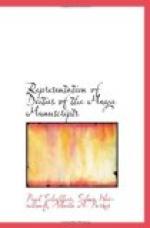In regard to the name of the death-god in the Maya language, Landa tells us that the wicked after death were banished to an underworld, the name of which was “Mitnal”, a word which is defined as “Hell” in the Maya lexicon of Pio Perez and which has a striking resemblance to Mictlan, the Aztec name for the lower regions. The death-god Hunhau reigned in this underworld. According to other accounts (Hernandez), however, the death-god is called Ahpuch. These names can in no wise serve as aids to the explanation of the hieroglyphs of the death-god, since they have no etymologic connection with death or the heads of corpses and skulls, which form the main parts of the hieroglyph. Furthermore, the hieroglyphs of the gods certainly have a purely ideographic significance as already mentioned above, so that any relation between the names of the deities and their hieroglyphs cannot exist from the very nature of the case.
The day of the death-god is the day Cimi, death. The day-sign Cimi corresponds almost perfectly with the heads of corpses contained in the hieroglyphs of the death-god.
A hieroglyphic sign, which relates to death and the death-deity and occurs very frequently, is the sign Fig. 5, which is probably to be regarded as the ideogram of the owl. It represents the head of an owl, while the figure in front of it signifies the owl’s ear and the one below, its teeth, as distinguishing marks of a bird of prey furnished with ears and a powerful beak. The head of the owl appears on a human body several times in the Dresden manuscript as a substitute for the death-deity, thus Dr. 18c, 19c, 20a and 20c and in other places, and the hieroglyphic group (Fig. 5) is almost a regular attendant hieroglyph of the death-god.
A series of other figures of the Maya mythology is connected with the death-god. This is evident from the fact that his hieroglyphs or his symbols occur with certain other figures, which are thus brought into connection with death and the death-deity.
These figures are as follows:
1. His companion, god F, the god of war, of human sacrifice and of violent death in battle, apparently a counterpart of the Aztec Xipe, who will be discussed farther on.
2. The moan bird. See beyond under Mythological Animals, No. 1.
3. The dog. See the same, No. 3.
4. A human figure, possibly representing the priest of the death-god (see Dr. 28, centre, Dr. 5b and 9a). The last figure is a little doubtful. It is blindfolded and thus recalls the Aztec deity of frost and sin, Itztlacoliuhqui. A similar form with eyes bound occurs only once again in the Maya manuscripts, namely Dr. 50 (centre). That this figure is related to the death-god is proved by the fact that on Dr. 9a it wears the Cimi-sign on the middle piece of the chain around its neck. Furthermore it should be emphasized that the Aztec sin-god, Itztlacoliuhqui, likewise appears with symbols of death.




